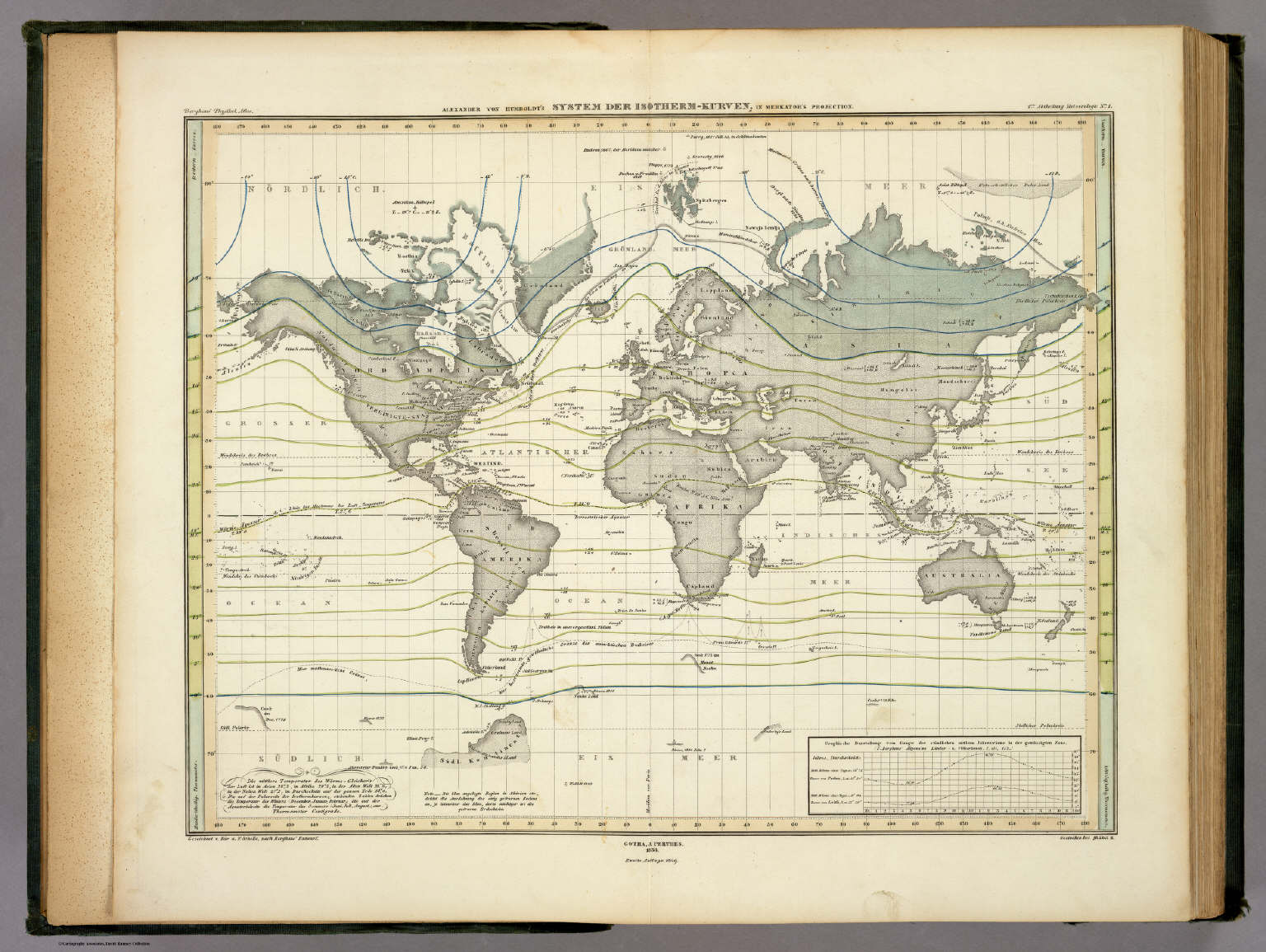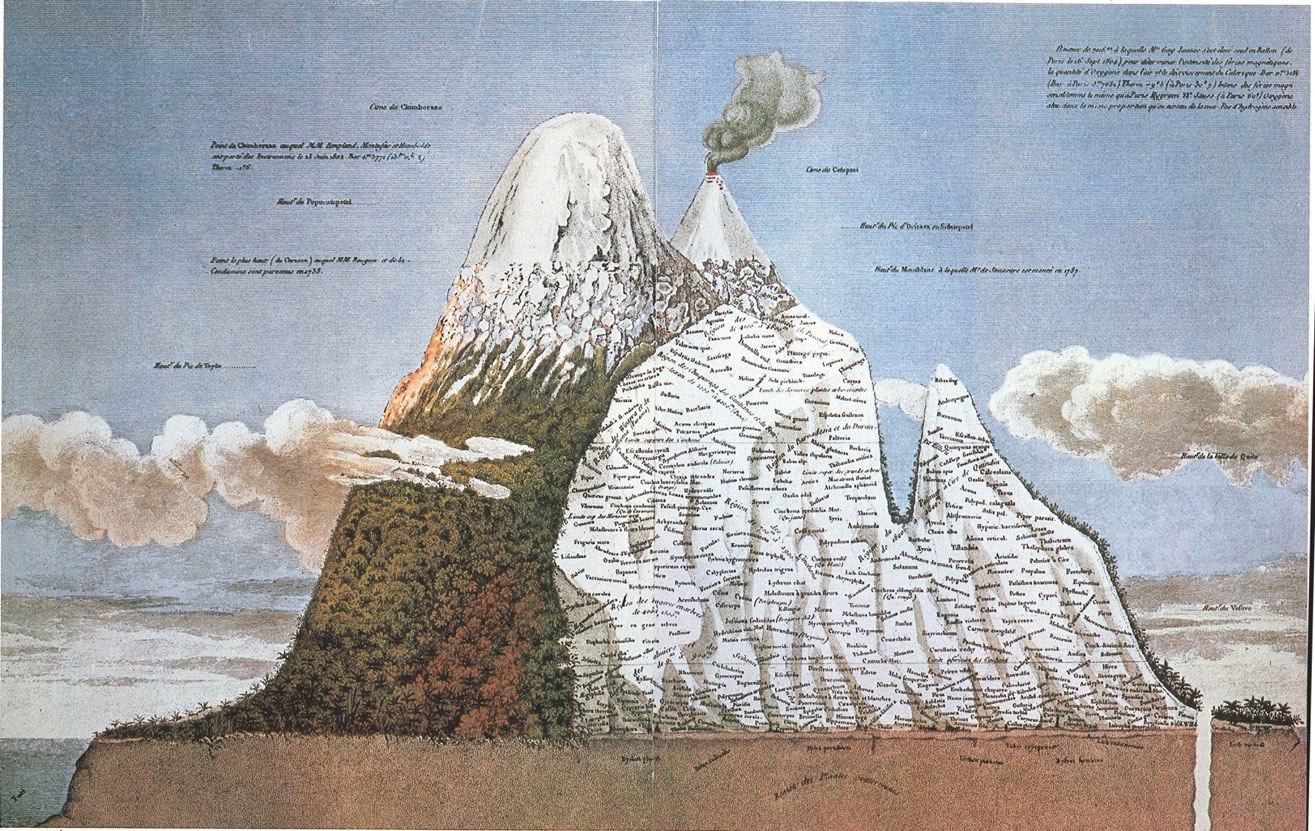What’s the first thing you think of when I say Humboldt? If you’re from California you could be thinking of the county, college, bay, fort, state park or wildlife refuge. If you’re from Nevada you might think of the river, the national forest, wildlife area, sink, saltmarsh, lake, mountain ranges, county or creepy ghost town. Dewy-Humboldt in Arizona, Humboldt Illinois, Humboldt Kansas, Humboldt Iowa, Humboldt Ohio, Humboldt Wisconsin, Humboldt Saskatchewan, Humboldt Nebraska, it’s hard to escape Humboldt. Humboldt is everywhere. The Humboldt name graces multiple mountains and mountain ranges, forests, national parks, waterfalls, glaciers, an ocean current. and a giant sinkhole Animals and plants including, penguins, squid, bat, monkey(s), skunk, snail, an entire genus of flowering plants, legumes, endangered cactus, a beetle, river dolphins, a carnivorous plant, oak, orchid, lily and mushroom all bear his name. Humboldt is in outer space, the Mare Humboldt on the moon and two asteroids bear the name. That doesn’t even touch the organizations, institutions, monuments and other random things that are all called Humboldt.
They’re all named for the same man, Alexander von Humboldt
Humboldt was a Prussian scientist, naturalist and geologist, (1769-1859) and you’ve probably never heard of him. That’s not a hipsterish way of saying Humboldt was “underground” man. There’s literally nobody else on earth with more things named after him. In his day, he was one of the most famous and influential people in the world, considered second only to Napoleon. Think about that for a minute. During the Napoleonic Wars the second-most-influential man was a scientist, humanitarian and explorer. Who was this man? What did he do? Humboldt was the last great polymath, a Romantic Scientist in a time headed toward our modern state of scientific specialization. He was the father of ecology and probably the first environmentalist. He discovered ocean currents, the magnetic equator and the origin of magnetic storms, plant geography and climate zones. He studied human migration and South American indigenous cultures while writing extensively about the evils of slavery and the legitimacy of pre-Colombian cultures.
Alexander von Humboldt spent his early life disappointing his parents. He was outdoorsy and adventurous. The young Humboldt spent so much time collecting plants and insects that his parents teasingly dubbed him “the little apothecary”. Humboldt was more blunt about it, dubbing the family home The Castle of Boredom. When he was older, Humboldt travelled Europe with Joseph Banks, a naturalist who had sailed with Captain Cook. When his father died, the Humboldt’s widowed mother insisted he become a mine inspector. Humboldt agreed, studied geology and managed mines for the Prussian government for five years, during which time he invented safer lamps for miners, opened a mining school, started an emergency fund for injured miners and cataloged species of subterranean plants. When his mother, Maria Elisabeth von Humboldt, died in 1796 Alexander was freed of family control and left with an impressive fortune. He could have lived comfortably for the rest of his life but he decided to spend most of it on science (because why not).
A map of Alexander von Humboldt's expedition through South America (source)
In 1799, Humboldt convinced Charles the Fourth of Spain to permit him and his friend Aime Bonpland (who happened to be both a doctor and botanist) to travel through South America. At the time South America, Mexico and a large part of the American West were part of New Spain. The Spanish Crown had kept these lands deliberately isolated from foreigners. Luckily, Humboldt happened to arrive during the Spanish Enlightenment when the crown was eager to find new ways to make money off it's colonial possessions so the arrival of a Prussian geologist and miner with his own expedition money was exactly what the Bourbons were after.
With royal documents in hand Humboldt and Bonpland set off for Havana. Unfortunately, an outbreak of typhoid on their ship forced them to land in Venezuela instead. Undeterred, Humboldt decided to explore. He explored the Guacharo cavern and in the process provided the first scientific documentation of the oilbird. He climbed Avila mont, now a national park near Caracas, all the while taking samples of plants and measuring air pressure, magnetic fields, temperature and other meteorological data. With Bonpanland, he travelled up the Orinoco river, covering 1700 miles of wild country. They documented the connection between the Orinoco and the Amazon, then unknown to Europeans and "discovered" electric eels. He transcribed the vocabularies of indigenous people and sketched ruins in the Amazon rainforest.
After a year an a half of exploring Venezuela Humboldt finally made it to Havana only to turn around and trek 25,000 miles across the Andes. While crossing through the Llanos grasslands in the eastern Andean foothills he noted the way that animal life relied on the Mauritia palm, the first observations of what we now call "keystone species", a species upon which an entire organism depends. He continued to take measurements and plant samples and began to formulate large-scale observations about the way that organisms and climate systems interact. He noted way that deforestation devastated local water quality, the way that forests cooled the climate through transpiration and shade. He sketched and noted the locations of Incan ruins. When he reached Ecuador he decided to climb Chimborazo, then thought the be the tallest mountain in the world, all the while lugging his scientific equipment and taking measurements. He travelled through Mexico, and documented the people who lived there. His critique of the Spanish regime and assertion of the dignity and sophistication of the native people would make him a hero in many anti-Spanish independence movements.
A map of the Earth's crust, fissures, volcanic activity, flora and fauna of the Andes produced by Humboldt (source)
When he would eventually return to Europe in 1805, bearing 60,000 plant specimens and a continent's worth of comparative climate data, cultural observations, illustrations and electromagnetic experimental data he challenged the prevaliing, scientific notions of the time. He examined his data holistically, not in isolation, and tried to explain natural phenomena without any appeal to religious opinion. This led him to the idea of "The Unity of Nature", that the interplay of all physical science determined what organisms could live in a region. He displayed these relationships on maps as isothermal lines, comparing climate across countries and continents, based on temperature, latitude and elevation.





This kind of thinking was completely unheard of. Naturalists and biologists were still trapped under the philosophical heel of Aristotle and his Christian proponents. Nature was there for the sake of man. Animal life was inexhaustible. Plant life would never disappear. Animals and plants do not go extinct nor do they rely terribly on one another. It was the duty of mankind to bring nature into line through settlement and agriculture. Humboldt's Unity of Nature challenged these assumptions. To Humboldt, humans weren't the focal point of the universe but humans could cause their own extinction through "The destructions of forests, through the distribution of water and through the productions of great masses of steam and gas in industrial centers". Large scale deforestation in Venezuela and Mexico, he warned, would turn the country into deserts. " The wants and restless activity of large communities of men gradually despoil the face of the Earth"
His worked earned him international fame in his own lifetime. Humboldt was admitted to the American Philosophical Society, The Prussian Academy of Sciences, The New York Historical Society, The American Ethnological Society, The American Academy of Arts and Sciences, The Royal Swedish Academy of Arts and Sciences, and the Royal Society. He talked extensively with Jefferson on his return trip, sharing troves of data that might have influenced Jefferson to pursue the Louisiana Purchase. Humboldt's fame, scientific acumen and his support of indigenous inhabitants of New Spain and disgust with slavery led early German-Americans to adopt him as an icon, naming towns and cities after him. German-American Quakers had founded the abolitionists, after all. He inspired Henry David Thoreau, Robert Frost, John Muir, George Perkins Marsh and Charles Darwin. Humboldt and Darwin corresponded as the young Darwin published his first works. Humboldt met and befriended Simon Bolivar when the two were in Paris. The two climbed Mount Vesuvius together. Bolivar called him the "true discoverer of South America". Muir, 70 years after his death, wished he "could be a young Humboldt".
A portrait of a young Humboldt (Public Domain)
Humboldt died at age 89 from a stroke. He never slowed down in his age, and continued to publish works right up until his death. His multi-volume opus Kosmos, detailing his discoveries and scientific philosophy, was still being revised and was only "completed" posthumously. It was, at the time, an international bestseller. He was never married. When Humboldt's letters to friends and acquaintances were discovered by biographers it was revealed that he had been amorously corresponding with men. Childhood friends and travelling companions received these letters. He may have even lost friends over his amorousness, driving away Francisco Jose de Caldas, the Colombian naturalist and revolutionary. Four years before his death, Humboldt amended his will and left his entire estate to his valet, a man by the name of Johann Seifert. Seifert had served him since 1827 and accompanied Humboldt's ill-fated 1829 Russian expedition. According to some biographers, sneaking same-sex partners into the home as servants was relatively common. While it's impossible to determine if any of these relationships were sexual or just intense friendships, the lack of marriage and the willing of the Humboldt estate to Seifert indicates that Humboldt was possibly gay or bisexual.
I don't bring the matter of Humboldt's sexual orientation lightly or out of some kind tabloid-esq desire to unmask a great figure. I mean, the man is centuries dead and largely forgotten. There's no mask to take off. The man's mystique and fame were destroyed in English-speaking world by two World Wars and a backlash against Germans. The topic of Humboldt's sexuality is important in that this month is Pride Month. There are scarce examples of LGBT scientists, mathematicians or engineers (name one aside from Alan Turing, I'll wait). That one of the greatest scientific thinkers of the 18th century was probably gay should be celebrated.
It's important that we recognize the impact of Humboldt's work and life because we've never been more in need of Humboldtian thinking. Glaciers are melting at an alarming pace. The oceans are warming and acidifying, bleaching The Great Barrier Reef. Drought has gripped California for four years and parts of the west have not seen rain in twelve. Invasive pests threaten our forests and our waterways. We need the kind of broad-spectrum, holistic, precise and cross-disciplinary science that Humboldt was famous for to address these complicated, multinational problems. We need Humboldtian humanism, to recognize the injustices perpetuated against native peoples, many of whom are losing their islands to sea-level rise. We need to acknowledge his sexuality to show LGBT youth that there is a path for them in science, that they can achieve great things.
Humboldt, in many ways, was a man before his time. and of his time. He developed such a thoroughly-modern understanding of the way that living things interact with each other and the environment that we forgot that it had to be developed in the first place. He was a strict empirical, scientist at a time when it was appropriate to cite God when discussing nature. He disagreed and railed against American and Spanish slavery and treatment of native peoples at a time when racial caste systems were "scientific". Humboldt, from beyond the grave, from two centuries ago is relevant. This month, for Pride Month, I urge you to rediscover Humboldt and connect with one of the foundations of the environmental movement.




